Biostar IDEQ 330P
Overview
Moving on to the newcomers, we have the most recently launched 939 SFF from Biostar. Biostar is a tier two manufacturer that has been around for some time. They've been making motherboards for a long time, and they've also been in the SFF market almost as long as Shuttle. Their IDEQ line has included some innovative and creative approaches, and the new 300 series offers some of the more interesting features that we've seen. We're looking at the 330P for this roundup, and it certainly has a lot to offer.Aesthetics
The first impression of the 330P is that it's shiny. Really shiny! (It also attracts fingerprints and dust exceptionally well, but that's typical of high-gloss surfaces.) Some people may prefer a matte finish instead, but the glossy paint definitely gives the 330P an air of sleekness. We've seen quite a few SFF cases now, and whatever else you might say of the 330P, it certainly stands out from the crowd.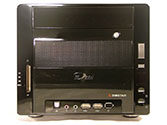 |
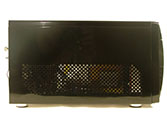 |
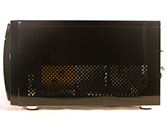 |
| Click on images to enlarge. | ||
The Biostar case is actually a bit wider than most of the other cases, but there's a reason for that. We also like the less obtrusive front panel lighting; a couple of indicators for HDD and power are all that you see, though the power button does glow orange when the PC is turned off. Something else that we like is that Biostar didn't bother with a door to hide the USB and other front ports. We use such ports frequently, so a door just gets in the way and is one more part that can break off.
One of the few items that give us any cause for concern as far as appearance is the front grille, where air is pulled in to cool the CPU. Dust is bound to collect there over time, and while it may serve as a reminder that it's time to clean out the inside of your PC, ignorance is bliss. It's a minor point, and some people will just like the visual highlight that it provides. Just remember to wipe it off with a damp cloth periodically and you should be fine.
Features
|
Biostar 330P
|
||
| Dimensions | (w)215 mm x (h)185 mm x (d)355 mm | |
| CPU Support | AMD Socket 939 up to FX-57/X24800+ | |
| Memory Support | PC1600/PC2100/PC2700/PC3200 up to 2GB; 2 DIMM slots |
|
| Motherboard | K8NBD-S9 (proprietary) NVIDIA nForce4 Chipset (not Ultra, not 4X) 1X-5X (200-1000MHz) HyperTransport 8-bit/8-bit to 16-bit/16-bit HT Width |
|
| Flash Reader | CF I/II, MD, SM/SMC, SD, MMC, and MS/MSP | |
| Expansion Slots | 1 x PCIe X16; 1 x PCI; 1 x mini PCI | |
| Power Supply | 300W Power Supply 2 x 4-pin Molex; Molex to 2 x SATA plus 2 x 4-pin Molex splitter 2 x 4-pin Power; 1 x 12-pin Proprietary Power |
|
| Internal Connections | 2 x SATA; 2 x IDE | |
| Audio | Realtek ALC850 7.1 (non-HD) | |
| LAN | 1 x 10/100/1000 Mbps (NVIDIA + VITESSE on PCIe) | |
| Drive Bays | 2 x 3.5 Internal (HDD) 1 x 5.25 External (CD/DVD) |
|
| Front I/O | 2 x USB 2.0 1 x IEEE1394 (6pin) MIC, Head-phone, S/PDIF IN Power & Reset buttons Power on & HDD LED indicators |
|
| Rear I/O | 4 x USB 2.0 1 x IEEE1394 (6pin) PS/2 KB, PS/2 Mouse 2 x COM (Serial) RJ-45 LAN Port (10/100/1000Mbps) Line-in, S/PDIF OUT Optical Center/Sub, L/R Front, L/R Surround, L/R Surround B |
|
| Overclocking | CPU 200-300; CPU Ratio 4X-Max; Vcc 0.800-1.700V; DDR Auto, 2.75-2.95V |
|
| Extras | Optional 802.11G Mini-PCI | |
| Full Image Set | Biostar 330P Pictures (7.2MB) | |
| Manufacturer Link | Biostar 330P | |
Features start out with the typical stuff: you get PCI Express graphics, integrated gigabit networking (on the PCIe bus), and support for socket 939 processors. Sound is also onboard, provided by the Realtek ALC850 chip and codec. One thing we always like to verify is that the front audio ports work well. Unfortunately, the 330P didn't meet our expectations, as our headphones had a substantial amount of static on them. The rear ports didn't have any issues, so if you plan on using head phones, you'll want a pair with a longer cord that can easily reach the rear jack.
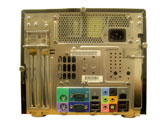 |
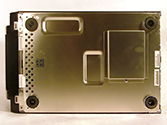 |
| Click on images to enlarge. | |
Since it's based on the same nForce4 chipset, the basic features are very similar to the Shuttle SN25P, the biggest competitor to the 330P. The differences are in the details. Where the SN25P has room for up to four hard drives, the 330P "only" has space for two. Two drives are generally enough for most people, so we're not too concerned. The 330P has two HDD cages that install into the top area of the case, and the power is provided for all the devices by a 300W PSU. In our testing, we didn't get above 235W under load, so 300W should be more than enough.
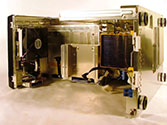 |
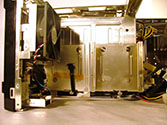 |
| Click on images to enlarge. | |
Another noteworthy difference is that a floppy drive can't be installed in the 330P; and when we say no floppy, we really mean no floppy - there isn't even a floppy cable connection on the motherboard. (Oddly enough, BIOS entries for FDD support still exist.) Frankly, we consider that to be a good thing. If you can't use a floppy drive, we would hope that support for all the critical functions is available without the floppy. SATA drive support for Windows works without a driver disk, and flashing the BIOS can be done from within Windows. You can also boot off of a flash device or USB stick if necessary. If you're looking to install XP to a RAID array, though, you're in for some problems. Your best bet would be to either slipstream the appropriate drivers onto an XP CD, or else try to use an imaging tool to restore a single hard drive image (with everything already set up) onto a RAID partition. An external USB floppy drive could also work. We didn't do any Linux compatibility testing either, so if that's your cup of tea, we'd suggest asking around the forums.
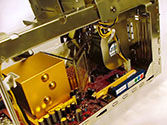 |
 |
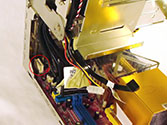 |
| Click on images to enlarge. | ||
In terms of expansion cards, the 330P receives top marks in the SFF market as it includes several options. First, you get the obligatory PCIe X16 slot. Next to that is a PCI slot, which is currently more useful than a PCIe X1 slot. On the other side of the case is another slot, but we're not quite sure what it is. (See the far right image above.) It's about the size of a PCIe X1 slot, but the wiring is clearly wrong. It's also not an AMR, CNR, or ACR as it's not the correct size for those either. The slot isn't mentioned anywhere in the manual or elsewhere, so it may simply be for internal debugging tools at Biostar. (We're trying to get an answer from Biostar about this slot.) Whatever the purpose of the slot, there isn't much room, so installing anything other than a very small card would be difficult. Besides the expansion slots on the top of the motherboard, Biostar has their "hidden" mini-PCI slot on the bottom of the case. If you're interested in adding WiFi connectivity to a SFF, it's a great option and it's something that we don't see in most other SFFs.
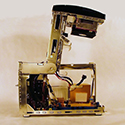 |
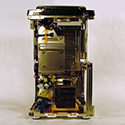 |
 |
| Click on images to enlarge. | ||
The big claim to fame of the new 300 series of Biostar cases is their hinged design. After removing the panels, you can lift up the entire front and top of the case to provide better access to the CPU socket, DIMM slots, etc. It does work, and it's a bit easier to install a lot of the equipment this way, but it isn't the most amazing thing in the world. If you were to access the internals of your system frequently, it would prove useful, but that's not usually how SFF owners use their systems. Would we purchase such a system over one of the other designs? All other things being equal, it's nice to have, but it's about the same as the tool-less features of the SN25P - good, but not something that would really sway our decision on its own. We'd buy the case for its appearance more than for the pop-top design.










29 Comments
View All Comments
JarredWalton - Wednesday, August 10, 2005 - link
So I spoke too soon. After finishing this article, I just happend to come across http://www.newegg.com/Product/Product.asp?Item=N82...">the new Aopen 939 SFF. That actually looks pretty promising, though the IGP isn't going to beat the ST20G5 that I can see (no DVI port). Time to put in a request for that unit....rqle - Wednesday, August 10, 2005 - link
Price of these SFF are getting quite pricey lately. So much to the point when you add the cpu, hard drive, memory, video card, optical drive AND LCD it will comes very close to the price of a good high end laptop on a good day. Dell 17inch 9300 w/6800 on a VERY good sale day comes just over the price of these SFF 'system.' Big fan of these SFF, but prices should be a little bit more reasonable for me to buy again.JarredWalton - Wednesday, August 10, 2005 - link
I agree with you on a lot of that, but a SFF with a 19" (or larger) LCD and a 6800GT/X800XL is pretty much going to stomp all over any similarly priced laptop. There's basically a $150 price premium to get a high-end SFF case, which is going to prevent many from buying. Still, some people buy $200 cases just because they look nice, so it's all a matter of taste.If you need portability, though, there are very few options other than getting a laptop. Personally, laptops and gaming are something I just don't care about. I'd get a cheap laptop for the office work I do and then keep a second system at home for any gaming. Some of course feel otherwise, but laptop keyboards and such just don't do it for me.
R3MF - Wednesday, August 10, 2005 - link
love it.BigT383 - Wednesday, August 10, 2005 - link
I have a first-generation SN95G5. I bought it thinking that since it's socket 939 I'd be able to upgrade to dual-core when it came out.Apparently this isn't the case, but I haven't seen anybody say they've tried it yet- so far there seem to be only rumors.
So I know this is a weird request but what I'd like to see right now is an article testing a CPU like the Athlon X2 4400+ on the three different versions of the SN95G5.
I can understand that X2s need a bios update, but the physical motherboard shouldn't be holding me back, right?
dcuccia - Thursday, August 18, 2005 - link
X2 support for the SN25P w/o USB2 issues is now available through a BIOS upgrade:http://www.shuttle.com/share/fae/hq/download/bios_...">http://www.shuttle.com/share/fae/hq/download/bios_...
JarredWalton - Thursday, August 18, 2005 - link
Thanks, I made a quick comment on the SN25P page to mention this.JarredWalton - Wednesday, August 10, 2005 - link
I'm going to be dropping an X2 3800+ into the SN95G5v2 just to see what happens. I'll try to get some official word from Shuttle on the matter as well. I really have no idea what the SN95G5v1 will support. I think the main change between it and v2 was a switch from an 80mm fan to a 92mm fan.Zirconium - Wednesday, August 10, 2005 - link
I love the roundup articles. I find them to be the most useful because they allow you to hone in on what you are looking for quickly, and then you can go to other sites and check the reviews that are solely for the products you are looking for.That said, one thing I'm interested is the quality of the integrated graphics on these computers. I have an SK41G and I could tell the difference between the quality of the built-in graphics and the AIW Radeon 7500 that is currently in it. When the integrated graphics were hooked up to a TV (I tried two) you could notice bands moving up the TV.